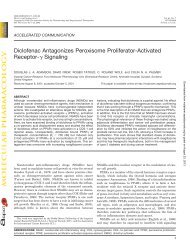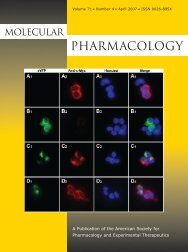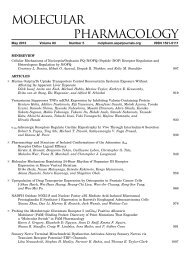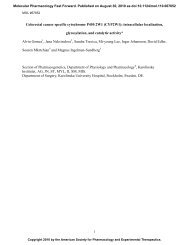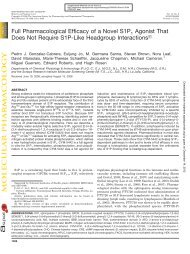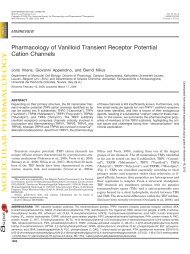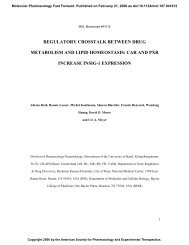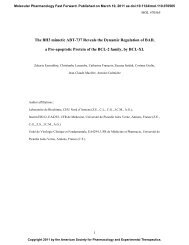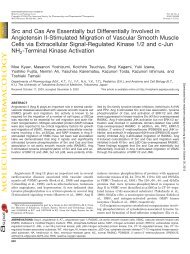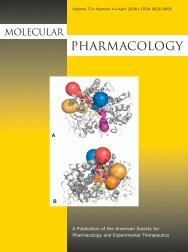Interaction Studies of Multiple Binding Sites on M4 Muscarinic ...
Interaction Studies of Multiple Binding Sites on M4 Muscarinic ...
Interaction Studies of Multiple Binding Sites on M4 Muscarinic ...
Create successful ePaper yourself
Turn your PDF publications into a flip-book with our unique Google optimized e-Paper software.
Allosteric Cross-<str<strong>on</strong>g>Interacti<strong>on</strong></str<strong>on</strong>g>s at M 4 <strong>Muscarinic</strong> Receptors 745<br />
erativity between allosteric sites can be retained in the presence<br />
<str<strong>on</strong>g>of</str<strong>on</strong>g> other orthosteric ligands, it is possible that different<br />
modulators may be combined to produce additive effects with<br />
respect to modulati<strong>on</strong> <str<strong>on</strong>g>of</str<strong>on</strong>g> the orthosteric site but have no<br />
effect <strong>on</strong> each other.<br />
The additi<strong>on</strong>al use <str<strong>on</strong>g>of</str<strong>on</strong>g> dissociati<strong>on</strong> kinetic experiments in<br />
our study was important because it allowed for an independent<br />
measurement <str<strong>on</strong>g>of</str<strong>on</strong>g> the parameter, , for the interacti<strong>on</strong><br />
between WIN 62,577 and C 7 /3-phth <strong>on</strong> the [ 3 H]NMS-occupied<br />
receptor. Figure 10 shows that both C 7 /3-phth and WIN<br />
62,577 were able to cause a c<strong>on</strong>centrati<strong>on</strong>-dependent retardati<strong>on</strong><br />
<str<strong>on</strong>g>of</str<strong>on</strong>g> [ 3 H]NMS dissociati<strong>on</strong> from the M 4 mAChR. Because<br />
the potency <str<strong>on</strong>g>of</str<strong>on</strong>g> WIN 62,577 was unaltered by the presence<br />
<str<strong>on</strong>g>of</str<strong>on</strong>g> C 7 /3-phth, this clearly indicated that the two<br />
modulators were not competing for the same site but were<br />
binding to separate sites with neutral cooperativity ( 1). It<br />
should be noted that these dissociati<strong>on</strong> kinetic experiments<br />
used [ 3 H]NMS instead <str<strong>on</strong>g>of</str<strong>on</strong>g> [ 3 H]QNB. Although use <str<strong>on</strong>g>of</str<strong>on</strong>g> the latter<br />
radioligand would have been preferred to allow for direct<br />
comparis<strong>on</strong> with the pseudoequilibrium binding data, this<br />
was not possible because <str<strong>on</strong>g>of</str<strong>on</strong>g> the very slow dissociati<strong>on</strong> time <str<strong>on</strong>g>of</str<strong>on</strong>g><br />
[ 3 H]QNB under our assay c<strong>on</strong>diti<strong>on</strong>s (data not shown). Nevertheless,<br />
the direct dem<strong>on</strong>strati<strong>on</strong> <str<strong>on</strong>g>of</str<strong>on</strong>g> neutral cooperativity<br />
between two modulators <strong>on</strong> an orthosteric ligand-occupied<br />
receptor is sufficient to validate the c<strong>on</strong>cept.<br />
It should also be noted that the experiments reported<br />
herein were c<strong>on</strong>ducted in a buffer c<strong>on</strong>taining high salt and<br />
high calcium c<strong>on</strong>centrati<strong>on</strong>s. This buffer was chosen because<br />
we have used it previously for intact cell studies (Avlani et<br />
al., 2004; Lanzafame and Christopoulos, 2004) and wanted to<br />
ensure that ligand potencies were determined under similar<br />
assay c<strong>on</strong>diti<strong>on</strong>s. However, the high i<strong>on</strong>ic strength <str<strong>on</strong>g>of</str<strong>on</strong>g> this<br />
buffer, although appropriate for the extracellular milieu, is<br />
not physiological with respect to the intracellular milieu that<br />
is accessible in our membrane preparati<strong>on</strong>s. N<strong>on</strong>etheless, we<br />
do not believe that this compromises our findings for the<br />
following reas<strong>on</strong>s. First, the fact that high i<strong>on</strong>ic strength<br />
reduces receptor-G protein interacti<strong>on</strong> was actually a desired<br />
outcome, because we wanted to focus <strong>on</strong> interacti<strong>on</strong>s occurring<br />
<strong>on</strong> the free (uncoupled) receptor [hence our additi<strong>on</strong>al<br />
inclusi<strong>on</strong> <str<strong>on</strong>g>of</str<strong>on</strong>g> Gpp(NH)p in all experiments involving ag<strong>on</strong>ists].<br />
Sec<strong>on</strong>d, our estimates <str<strong>on</strong>g>of</str<strong>on</strong>g> the affinity and cooperativity <str<strong>on</strong>g>of</str<strong>on</strong>g><br />
WIN 62,577 with [ 3 H]NMS and ACh are in excellent agreement<br />
with those obtained previously by Lazareno et al.<br />
(2000) using a buffer different from ours. Thus, we are c<strong>on</strong>fident<br />
that our findings are applicable to the intact cell situati<strong>on</strong>,<br />
where the G protein-uncoupled state <str<strong>on</strong>g>of</str<strong>on</strong>g> the receptor is<br />
the predominant state (Kenakin, 1997), and the interacti<strong>on</strong>s<br />
we are quantifying are expected to occur at the extracellular<br />
face <str<strong>on</strong>g>of</str<strong>on</strong>g> the receptor.<br />
In c<strong>on</strong>clusi<strong>on</strong>, this study has characterized the interacti<strong>on</strong><br />
<str<strong>on</strong>g>of</str<strong>on</strong>g> novel allosteric modulators <str<strong>on</strong>g>of</str<strong>on</strong>g> the M 1 and M 4 mAChRs<br />
with a variety <str<strong>on</strong>g>of</str<strong>on</strong>g> orthosteric and prototypical allosteric modulators.<br />
In additi<strong>on</strong> to c<strong>on</strong>firming the presence <str<strong>on</strong>g>of</str<strong>on</strong>g> a sec<strong>on</strong>d<br />
allosteric site <strong>on</strong> the M 4 mAChR, this study derived quantitative<br />
estimates <str<strong>on</strong>g>of</str<strong>on</strong>g> cooperativity across three different binding<br />
sites <strong>on</strong> the M 4 mAChR, suggesting a greater window for<br />
the discovery <str<strong>on</strong>g>of</str<strong>on</strong>g> subtype-selective allosteric modulators<br />
and/or development <str<strong>on</strong>g>of</str<strong>on</strong>g> combinati<strong>on</strong> drug therapies than anticipated<br />
previously.<br />
Acknowledgments<br />
We thank Elizabeth Guida for excellent technical assistance.<br />
References<br />
Avlani VA, May LT, Sext<strong>on</strong> PM, and Christopoulos (2004) Applicati<strong>on</strong> <str<strong>on</strong>g>of</str<strong>on</strong>g> a kinetic<br />
model to the apparently complex behaviors <str<strong>on</strong>g>of</str<strong>on</strong>g> negative and positive allosteric<br />
modulators <str<strong>on</strong>g>of</str<strong>on</strong>g> muscarinic acetylcholine receptors. J Pharmacol Exp Ther 308:<br />
1062–1072.<br />
Birdsall NJ, Lazareno S, Popham A, and Saldanha J (2001) <str<strong>on</strong>g>Multiple</str<strong>on</strong>g> allosteric sites<br />
<strong>on</strong> muscarinic receptors. Life Sci 68:2517–2524.<br />
Bradford MM (1976) A rapid and sensitive method for the quantitati<strong>on</strong> <str<strong>on</strong>g>of</str<strong>on</strong>g> microgram<br />
quantities <str<strong>on</strong>g>of</str<strong>on</strong>g> protein utilizing the principle <str<strong>on</strong>g>of</str<strong>on</strong>g> protein-dye binding. Anal Biochem<br />
72:248–254.<br />
Choo LK and Mitchels<strong>on</strong> F (1989) Characterizati<strong>on</strong> <str<strong>on</strong>g>of</str<strong>on</strong>g> the antimuscarinic effect <str<strong>on</strong>g>of</str<strong>on</strong>g><br />
heptane-1,7-bis-(dimethyl-3-phthalimidopropyl amm<strong>on</strong>ium bromide). Eur<br />
J Pharmacol 162:429–435.<br />
Christopoulos A (1998) Assessing the distributi<strong>on</strong> <str<strong>on</strong>g>of</str<strong>on</strong>g> parameters in models <str<strong>on</strong>g>of</str<strong>on</strong>g> ligandreceptor<br />
interacti<strong>on</strong>: to log or not to log. Trends Pharmacol Sci 19:351–357.<br />
Christopoulos A (2000) Quantificati<strong>on</strong> <str<strong>on</strong>g>of</str<strong>on</strong>g> allosteric interacti<strong>on</strong>s at G protein-coupled<br />
receptors using radioligand binding assays, in Current Protocols in Pharmacology<br />
(Enna SJ ed) pp 1.22.21–1.22.40, Wiley and S<strong>on</strong>s, New York.<br />
Christopoulos A (2002) Allosteric binding sites <strong>on</strong> cell-surface receptors: novel targets<br />
for drug discovery. Nat Rev Drug Discov 1:198–210.<br />
Christopoulos A and Kenakin T (2002) G protein-coupled receptor allosterism and<br />
complexing. Pharmacol Rev 54:323–374.<br />
Christopoulos A, Loiac<strong>on</strong>o R, and Mitchels<strong>on</strong> F (1993) <str<strong>on</strong>g>Binding</str<strong>on</strong>g> <str<strong>on</strong>g>of</str<strong>on</strong>g> the muscarine<br />
receptor antag<strong>on</strong>ist heptane-1,7-bis(dimethyl-3-phthalimidopropyl)amm<strong>on</strong>ium<br />
bromide at cholinoceptor sites. Eur J Pharmacol 246:1–8.<br />
Christopoulos A and Mitchels<strong>on</strong> F (1994) Assessment <str<strong>on</strong>g>of</str<strong>on</strong>g> the allosteric interacti<strong>on</strong>s <str<strong>on</strong>g>of</str<strong>on</strong>g><br />
the bisquaternary heptane-1,7-bis(dimethyl-3-phthalimidopropyl)amm<strong>on</strong>ium<br />
bromide at M1 and M2 muscarine receptors. Mol Pharmacol 46:105–114.<br />
Christopoulos A, Sorman JL, Mitchels<strong>on</strong> F, and El-Fakahany EE (1999) Characterizati<strong>on</strong><br />
<str<strong>on</strong>g>of</str<strong>on</strong>g> the subtype selectivity <str<strong>on</strong>g>of</str<strong>on</strong>g> the allosteric modulator heptane-1,7-bis-<br />
(dimethyl-3-phthalimidopropyl) amm<strong>on</strong>ium bromide (C7/3-phth) at cl<strong>on</strong>ed muscarinic<br />
acetylcholine receptors. Biochem Pharmacol 57:171–179.<br />
Clark AL and Mitchels<strong>on</strong> F (1976) The inhibitory effect <str<strong>on</strong>g>of</str<strong>on</strong>g> gallamine <strong>on</strong> muscarinic<br />
receptors. Br J Pharmacol 58:323–331.<br />
Ehlert FJ (1988) Estimati<strong>on</strong> <str<strong>on</strong>g>of</str<strong>on</strong>g> the affinities <str<strong>on</strong>g>of</str<strong>on</strong>g> allosteric ligands using radioligand<br />
binding and pharmacological null methods. Mol Pharmacol 33:187–194.<br />
Ehlert FJ, Roeske WR, and Yamamura HI (1995) Molecular biology, pharmacology,<br />
and brain distributi<strong>on</strong> <str<strong>on</strong>g>of</str<strong>on</strong>g> subtypes <str<strong>on</strong>g>of</str<strong>on</strong>g> the muscarinic receptor, in Psychopharmacology:<br />
The Fourth Generati<strong>on</strong> <str<strong>on</strong>g>of</str<strong>on</strong>g> Progress (Bloom FE and Kupfer DJ eds) pp<br />
111–124, Raven Press, New York.<br />
Ellis J and Seidenberg M (1989) Gallamine exerts biphasic allosteric effects at<br />
muscarinic receptors. Mol Pharmacol 35:173–176.<br />
Ellis J and Seidenberg M (1992) Two allosteric modulators interact at a comm<strong>on</strong> site<br />
<strong>on</strong> cardiac muscarinic receptors. Mol Pharmacol 42:638–641.<br />
Felder CC, Bymaster FP, Ward J, and DeLapp N (2000) Therapeutic opportunities<br />
for muscarinic receptors in the central nervous system. J Med Chem 43:4333–<br />
4353.<br />
Gomeza J, Zhang L, Kostenis E, Felder CC, Bymaster FP, Brodkin J, Shann<strong>on</strong> H, Xia<br />
B, Duttaroy A, Deng CX, et al. (2001) Generati<strong>on</strong> and pharmacological analysis <str<strong>on</strong>g>of</str<strong>on</strong>g><br />
M2 and <strong>M4</strong> muscarinic receptor knockout mice. Life Sci 68:2457–2466.<br />
Hamilt<strong>on</strong> SE, Hardouin SN, Anagnostaras SG, Murphy GG, Richm<strong>on</strong>d KN, Silva AJ,<br />
Feigl EO, and Nathans<strong>on</strong> NM (2001) Alterati<strong>on</strong> <str<strong>on</strong>g>of</str<strong>on</strong>g> cardiovascular and neur<strong>on</strong>al<br />
functi<strong>on</strong> in M1 knockout mice. Life Sci 68:2489–2493.<br />
Hejnova L, Tuček S, and el-Fakahany EE (1995) Positive and negative allosteric<br />
interacti<strong>on</strong>s <strong>on</strong> muscarinic receptors. Eur J Pharmacol 291:427–430.<br />
Hulme EC, Birdsall NJ, and Buckley NJ (1990) <strong>Muscarinic</strong> receptor subtypes. Annu<br />
Rev Pharmacol Toxicol 30:633–673.<br />
Jakubík J, Bacakova L, el-Fakahany EE, and Tuček S (1995) Subtype selectivity <str<strong>on</strong>g>of</str<strong>on</strong>g><br />
the positive allosteric acti<strong>on</strong> <str<strong>on</strong>g>of</str<strong>on</strong>g> alcur<strong>on</strong>ium at cl<strong>on</strong>ed M1–M5 muscarinic acetylcholine<br />
receptors. J Pharmacol Exp Ther 274:1077–1083.<br />
Kenakin TP (1997) Pharmacologic Analysis <str<strong>on</strong>g>of</str<strong>on</strong>g> Drug-Receptor <str<strong>on</strong>g>Interacti<strong>on</strong></str<strong>on</strong>g>. Lippincott-<br />
Raven, Philadelphia, PA<br />
Kostenis E and Mohr K (1996) Two-point kinetic experiments to quantify allosteric<br />
effects <strong>on</strong> radioligand dissociati<strong>on</strong>. Trends Pharmacol Sci 17:280–283.<br />
Lanzafame A and Christopoulos A (2004) Investigati<strong>on</strong> <str<strong>on</strong>g>of</str<strong>on</strong>g> the interacti<strong>on</strong> <str<strong>on</strong>g>of</str<strong>on</strong>g> a putative<br />
allosteric modulator, SCH-202676, with M 1 muscarinic acetylcholine receptors.<br />
J Pharmacol Exp Ther 308:830–837.<br />
Lanzafame A, Christopoulos A, and Mitchels<strong>on</strong> F (1997) Three allosteric modulators<br />
act at a comm<strong>on</strong> site, distinct from that <str<strong>on</strong>g>of</str<strong>on</strong>g> competitive antag<strong>on</strong>ists, at muscarinic<br />
acetylcholine M2 receptors. J Pharmacol Exp Ther 282:278–285.<br />
Lazareno S and Birdsall NJ (1995) Detecti<strong>on</strong>, quantitati<strong>on</strong>, and verificati<strong>on</strong> <str<strong>on</strong>g>of</str<strong>on</strong>g><br />
allosteric interacti<strong>on</strong>s <str<strong>on</strong>g>of</str<strong>on</strong>g> agents with labeled and unlabeled ligands at G proteincoupled<br />
receptors: interacti<strong>on</strong>s <str<strong>on</strong>g>of</str<strong>on</strong>g> strychnine and acetylcholine at muscarinic receptors.<br />
Mol Pharmacol 48:362–378.<br />
Lazareno S, Gharagozloo P, Ku<strong>on</strong>en D, Popham A, and Birdsall NJ (1998) Subtypeselective<br />
positive cooperative interacti<strong>on</strong>s between brucine analogues and acetylcholine<br />
at muscarinic receptors: radioligand binding studies. Mol Pharmacol 53:<br />
573–589.<br />
Lazareno S, Popham A, and Birdsall NJ (2000) Allosteric interacti<strong>on</strong>s <str<strong>on</strong>g>of</str<strong>on</strong>g> staurosporine<br />
and other indolocarbazoles with N-[methyl- 3 H]scopolamine and acetylcholine<br />
at muscarinic receptor subtypes: identificati<strong>on</strong> <str<strong>on</strong>g>of</str<strong>on</strong>g> a sec<strong>on</strong>d allosteric site. Mol<br />
Pharmacol 58:194–207.<br />
Lazareno S, Popham A, and Birdsall NJ (2002) Analogs <str<strong>on</strong>g>of</str<strong>on</strong>g> WIN 62,577 define a<br />
sec<strong>on</strong>d allosteric site <strong>on</strong> muscarinic receptors. Mol Pharmacol 62:1492–1505.<br />
Lee NH and el-Fakahany EE (1988) Influence <str<strong>on</strong>g>of</str<strong>on</strong>g> ligand choice <strong>on</strong> the apparent<br />
binding pr<str<strong>on</strong>g>of</str<strong>on</strong>g>ile <str<strong>on</strong>g>of</str<strong>on</strong>g> gallamine to cardiac muscarinic receptors. Identificati<strong>on</strong> <str<strong>on</strong>g>of</str<strong>on</strong>g> three



